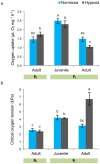Short-term acclimation in adults does not predict offspring acclimation potential to hypoxia
- PMID: 29453345
- PMCID: PMC5816618
- DOI: 10.1038/s41598-018-21490-y
Short-term acclimation in adults does not predict offspring acclimation potential to hypoxia
Abstract
The prevalence of hypoxic areas in coastal waters is predicted to increase and lead to reduced biodiversity. While the adult stages of many estuarine invertebrates can cope with short periods of hypoxia, it remains unclear whether that ability is present if animals are bred and reared under chronic hypoxia. We firstly investigated the effect of moderate, short-term environmental hypoxia (40% air saturation for one week) on metabolic performance in adults of an estuarine amphipod, and the fitness consequences of prolonged exposure. We then reared the offspring of hypoxia-exposed parents under hypoxia, and assessed their oxyregulatory ability under declining oxygen tensions as juveniles and adults. Adults from the parental generation were able to acclimate their metabolism to hypoxia after one week, employing mechanisms typically associated with prolonged exposure. Their progeny, however, did not develop the adult pattern of respiratory regulation when reared under chronic hypoxia, but instead exhibited a poorer oxyregulatory ability than their parents. We conclude that species apparently hypoxia-tolerant when tested in short-term experiments, could be physiologically compromised as adults if they develop under hypoxia. Consequently, we propose that the increased prevalence of hypoxia in coastal regions will have marked effects in some species currently considered hypoxia tolerant.
Conflict of interest statement
The authors declare no competing interests.
Figures



Similar articles
-
Acclimation to warming but not hypoxia alters thermal tolerance and metabolic sensitivity in an estuarine crustacean.Mar Environ Res. 2024 Jun;198:106565. doi: 10.1016/j.marenvres.2024.106565. Epub 2024 May 24. Mar Environ Res. 2024. PMID: 38815495
-
Consequences of thermal plasticity for hypoxic performance in coastal amphipods.Mar Environ Res. 2022 May;177:105624. doi: 10.1016/j.marenvres.2022.105624. Epub 2022 Apr 12. Mar Environ Res. 2022. PMID: 35436652
-
Moderate reductions in dissolved oxygen may compromise performance in an ecologically-important estuarine invertebrate.Sci Total Environ. 2019 Nov 25;693:133444. doi: 10.1016/j.scitotenv.2019.07.250. Epub 2019 Jul 17. Sci Total Environ. 2019. PMID: 31362229
-
Do aquatic ectotherms perform better under hypoxia after warm acclimation?J Exp Biol. 2021 Feb 4;224(Pt 3):jeb232512. doi: 10.1242/jeb.232512. J Exp Biol. 2021. PMID: 33542094 Review.
-
Heat acclimation and performance in hypoxic conditions.Aviat Space Environ Med. 2012 Jul;83(7):649-53. doi: 10.3357/asem.3241.2012. Aviat Space Environ Med. 2012. PMID: 22779306 Review.
Cited by
-
Hypoxia Disrupts Sex-Specific Physiology and Gene Expression Leading to Decreased Fitness in the Estuarine Sea Anemone Nematostella vectensis.Mol Ecol. 2025 May;34(9):e17755. doi: 10.1111/mec.17755. Epub 2025 Apr 7. Mol Ecol. 2025. PMID: 40192436 Free PMC article.
-
Toxic Algae Silence Physiological Responses to Multiple Climate Drivers in a Tropical Marine Food Chain.Front Physiol. 2019 Apr 4;10:373. doi: 10.3389/fphys.2019.00373. eCollection 2019. Front Physiol. 2019. PMID: 31019470 Free PMC article.
-
Will giant polar amphipods be first to fare badly in an oxygen-poor ocean? Testing hypotheses linking oxygen to body size.Philos Trans R Soc Lond B Biol Sci. 2019 Aug 5;374(1778):20190034. doi: 10.1098/rstb.2019.0034. Epub 2019 Jun 17. Philos Trans R Soc Lond B Biol Sci. 2019. PMID: 31203754 Free PMC article.
-
Paternal hypoxia exposure primes offspring for increased hypoxia resistance.BMC Biol. 2022 Aug 30;20(1):185. doi: 10.1186/s12915-022-01389-x. BMC Biol. 2022. PMID: 36038899 Free PMC article.
References
-
- Rabalais N, et al. Eutrophication-driven deoxygenation in the coastal ocean. Oceanography. 2014;27:172–183. doi: 10.5670/oceanog.2014.21. - DOI
-
- Levin LA, et al. Effects of natural and human-induced hypoxia on coastal benthos. Biogeosciences. 2009;6:2063–2098. doi: 10.5194/bg-6-2063-2009. - DOI
-
- Diaz R, Rosenberg R. Marine benthic hypoxia: A review of its ecological effects and the behavioural responses of benthic macrofauna. Oceanogr. Mar. Biol. 1995;33:245–303.
-
- Burnett, L. E. & Stickle, W. B. In Coastal hypoxia: consequences for living resources and ecosystems (eds. Rabalais, N. N. & Turner, R. E.) 101–114 (American Geophysical Union, 2001).
Publication types
MeSH terms
Substances
LinkOut - more resources
Full Text Sources
Other Literature Sources

